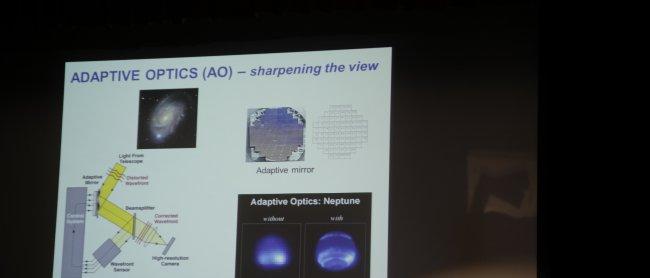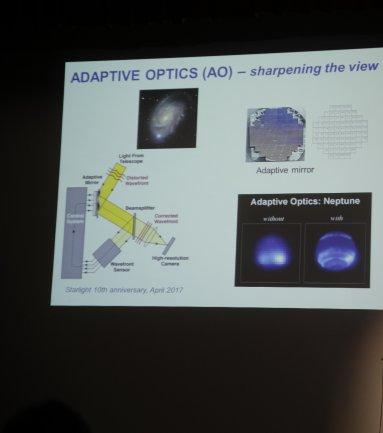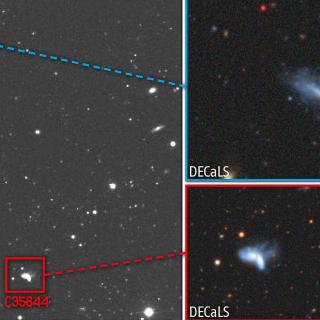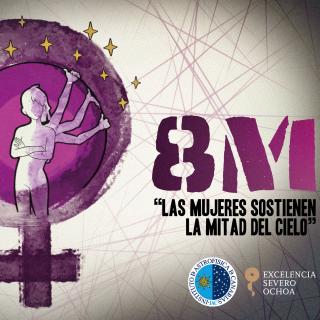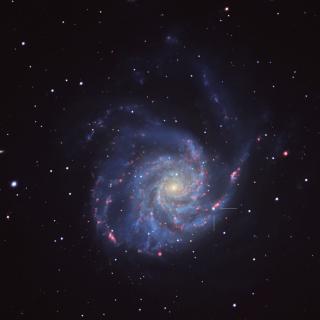"Excellent sites for studying the universe are characterized by their dark and sharp sky. The low turbulence in their atmospheres allows us to separated sources, stars or galaxies, which would appear as a single source from a site with poorer image quality. The darkness of the sky allows us to identify very faint objects which give us information about the origin and the history of our universe" . This was how Casiana Muñoz Tuñon, a researcher at the Instituto de Astrofísica de Canarias (IAC) and an expert in characterizing sky quality, opened the first of today's sessions of the "Preserving the Skies" conference on La Palma. This session, which was moderated by the British astronomer Alec Boksenberg, was dedicated to new technology in astronomy and intelligent lighting systems. " To take maximum advantage of the few excellent observing sites " said the IAC astrophysicist " we build large modern telescopes and use laser systems to create artificial stars to improve our capacity to see and identify galaxies or faint exoplanets" and she added " We need to protect these few excellent sites and implement forefront technology to obtain the maximum benefit for science".
Adaptive Optics for the TMT
Christophe Dumas, from the California Institute of Technology (CALTECH), Head of Operations of the International TMT (Thirty Metre Telescope) Observatory, talked about this telescope which might be built on La Palma, if it cannot, finally, be built on Mauna Kea (Hawaii). "We have determined" he stated,"that the Roque de los Muchachos Observatory is the best alternative site, because essential the two observatories have similar characteristics for siting the telescope" He gave a brief summary of the history of the project, its members, its parameters and the instrument suite planned for it (8 instruments). He gave special prominence to the adaptive optics (AO) which will incorporate laser guide star systems, and with which the telescope will attain a sensitivity tens of times superior to the current large 8a d 10 metre class telescopes, and a spacial resolution 12 times better than the Hubble Space Telescope. " The TMT will bring about an enormous transformation in astronomy during the coming decade, due to its 30m mirror, its site, the design of its dome, its AO systems, its simplfied optical design, and the flexibility in the design of its instruments.
Ängel Otarola, also a member of the TMT International Observatory explained in greater detail the different types of lasers which will act as guide stars, emphasizing the importance of Adaptive Optics to reach the diffraction limits of telescopes. "It is important" he stressed, " to coordinate telescopes which share the same part of the sky so that the light from each laser does not contaminate the spectra obtained.To avoid these problems of a clash of laserts, there is a suite of programmes Laser Traffic Control System (LTCS) which can foresee possible clashes between laser beams and the fields of view of other nearby telescopes. These lasers are not sources of light pollution, but they could cause interference which can be avoided by coordination between neighbouring telecopes.
LED Technology
The need to protect areas of outstanding natural beauty, to preserve their biodiversity, human health and the quality of the night sky in order to make good observations of the stars have been threatened by traditional street lighting. for that reason companies in this field are making efforts to innovated and to improve these lighting systems so that they cause the least possible contamination and damage, as was explained in some of the lectures at this conference.
Fabio Falchi, of the ISTIL (The Light Pollution Science and Technology Institute) explained a series of rules required to avoid light pollution, such as, zero light shining directly above the horizon from the streetlights, constant revisions to reduce the levels of luminance and illumination needed, protection of the band which suppresses the production of melatonin, and pointing the lighting exclusively towards the object requiring illumination
Javier Díaz Castro, in collaboration with Federico de la Paz, both technical specialists in the Office of Sky Quality Protection at the IAC talked about protection and about inoovation in strett lighting installations, in particular about the case of the island of La Palma. " We have analyzed LED technology" they explained " from the viewpoint of spectral radiance, to apply criteria of minimization of the impact of artificial lighting specified in the Law of the Sky of the Canaries (Law 31/88). The different criteria divide this technology, which must be technically and economically viable, into different types of LED: Pure Amber, Amber (PC Amber), and Warm White. The Pure Amber LEDs, although optically ideal, are of limited viability becasue of their low efficiency, so that the Amber type, with its higher efficiency, is gaining ground in protected areas. We are also studying the new Super Warm LED (2200º K) for particular areas.
Martin Aubé, of Sherbrooke University (Canada) commented in his lecture about the effects of economically efficient LEd technology on the exterior lighting industry and explained why the colour is so important for the preservation of the night-time environment. "Now we know that the presence of artificial lighting at night (ALAN) has significant consequences for the night sky, on the environment, on flora and fauna, and on human health. But what will be the impact of the current transition from high pressure sodium lights to white light LEDs?" According to this expert LEDs offer many possibilities.They are long lasting, easy to control, and in general allow a more efficient photometric design. "But this technology" he warned "is also characterized by its greater proportion of blue light, which is a major threat to night-time integrity, both for astronomy and for biology".
Previous press releases about "Preserving the Skies" conference:
